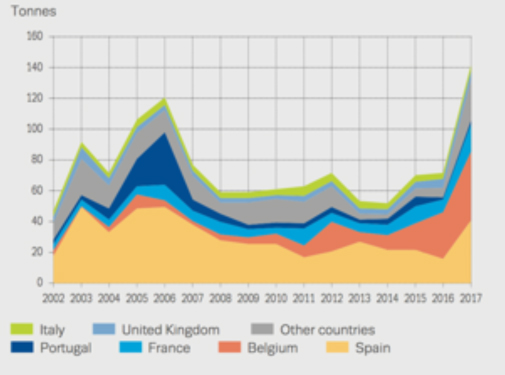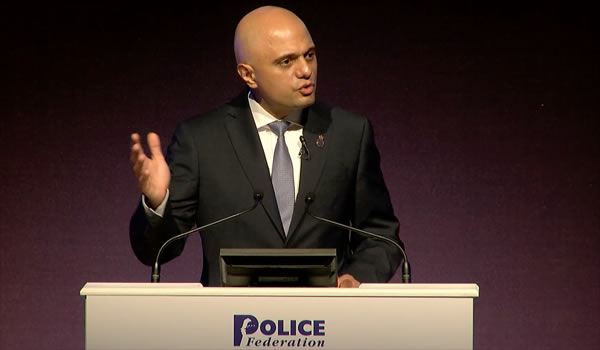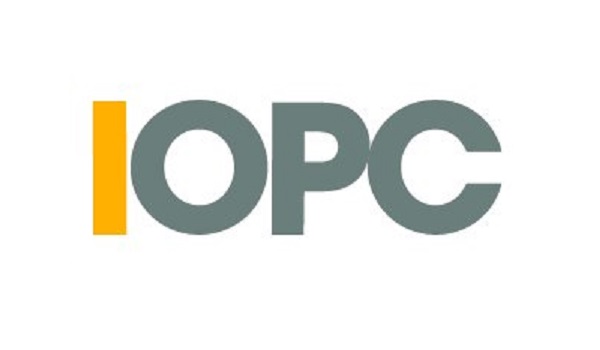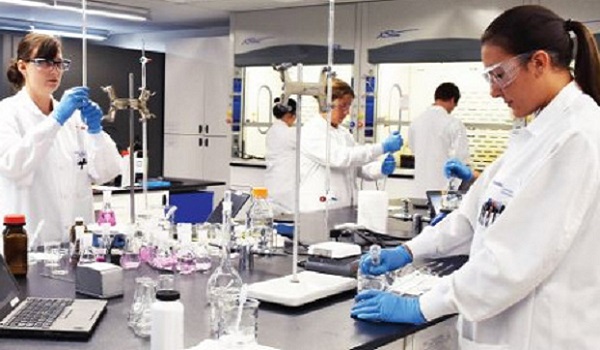EU cocaine supply being ‘uberised’
Seizures of cocaine are at record levels across Europe and dealers are using innovative methods to change the supply market, according to the latest analysis of drug market trends.
According to the annual report of the European Monitoring Centre for Drugs and Drug Addiction (EMCDDA), Europe is playing a growing role in synthetic drug production with problems emerging from the use of highly potent synthetic opioids, new production techniques for MDMA and amphetamines, and recent developments in the processing of morphine into heroin inside Europe’s borders.
In 2018, 55 new psychoactive substances (NPS) were detected in the EU for the first time, bringing the total number monitored by the agency to 730.
But it is the increased availability of cocaine that the EMCDDA highlights as the most significant trend, resulting in growing numbers of people seeking treatment for addiction.
The report European Drug Report 2019: Trends and Developments, published by the EMCDDA on Thursday (June 6), highlights the continuing high availability of most illicit substances. The latest data show that in Europe, over one million seizures of illicit drugs are reported annually. Around 96 million adults in the EU (15–64 years) have tried an illicit drug in their lifetime and an estimated 1.2 million people receive treatment each year for illicit drug use.
EMCDDA Director Alexis Goosdeel said: “The challenges we face in the drugs area continue to grow. Not only are there signs of increased availability of established plant-based drugs like cocaine, but we are also witnessing an evolving market where synthetic drugs and drug production within Europe are growing in importance.”
Data provided by all EU states plus Turkey and Norway show that both the number of seizures and quantities of cocaine seized were at record levels. Over 104,000 cocaine seizures were reported in the EU in 2017, up from 98,000 in 2016, which amounted to 140.4 tonnes, around double the quantity seized in 2016 (70.9 tonnes).
Although the retail price of cocaine across Europe remained stable, its purity at street level reached its highest level in a decade in 2017.
The EMCDDA said the growth in large-volume trafficking of cocaine, using maritime shipping containers, stands out as a major challenge.
Social media, darknet marketplaces and encryption techniques are playing an increasing role in enabling smaller groups and individuals to engage in drug dealing.
“Looking at the cocaine market, entrepreneurship can be seen in innovative distribution methods. One example is the existence of cocaine ‘call centres’, with couriers providing fast and flexible delivery. Such methods – reflecting a potential ‘uberisation’ of the cocaine trade – are indicative of a competitive market in which sellers compete by offering additional services beyond the product itself,” the report adds.
Cocaine is the most commonly used illicit stimulant drug in the EU, with around 2.6 million young adults (15–34 years) having used it in 2017.
A recent study of drug residues in municipal wastewater revealed that, between 2017 and 2018, there were increases in cocaine metabolites in 22 of the 38 cities with data for this period, confirming the upward trend also reported in 2017. In 2018, the highest residues standardised per 1,000 people per day were recorded in cities in Belgium, Spain, the Netherlands, and the UK (Bristol).
And there are signs that the increase in cocaine supply is associated with more reported health problems, the report claims. According to the latest estimates, around 73,000 people entered specialised drug treatment for cocaine-related problems. Of particular concern are the 11,000 of these who entered treatment for crack cocaine-related problems.
The number of ‘new’ clients reported as requiring treatment for a cocaine problem for the first time rose by 37 per cent between 2014 and 2017, suggesting treatment needs are growing. Cocaine was also the illicit drug most commonly reported in drug-related hospital emergency presentations recorded by a network of 26 sentinel hospitals in 18 European countries in 2017, including the UK.

Synthetic opioids
The EMCDDA reported a growing concern from new synthetic opioids being produced across the continent. With an “epidemic” in the United States and Canada largely driven by the use of these drugs, particularly fentanyl and its derivatives, they are increasingly being linked to recent poisonings and deaths in Europe.
Fentanyl derivatives make up the majority of the 49 new synthetic opioids monitored by the EMCDDA. Six fentanyl derivatives were detected in Europe for the first time in 2018 (34 detected since 2009). In the most recent data, these highly potent drugs accounted for 70 per cent of all seizures of the new synthetic opioids. Over 300 seizures of carfentanil were reported, one of the most potent drugs in this family. A total of 4.5 kg of a precursor chemical for the manufacture of fentanyl derivatives (N-phenethyl-4-piperidone) was also seized in the EU.
A total of 11 new synthetic opioids were detected in Europe in 2018, usually in the form of powders, tablets and liquids. With only very small volumes needed to produce many thousands of street doses, the EMCDDA said these substances are easy to conceal and transport, representing a challenge for law enforcement and customs.
However, heroin remains the most common illicit opioid on the drug market in Europe and is a major contributor to drug-related health and social costs.
The quantity of heroin seized in the EU increased by over a tonne in 2017 to 5.4 tonnes, with an additional 17.4 tonnes seized by Turkey (some of which would have been destined for the EU market).
The report says a worrying development is the 81 tonnes of the heroin precursor chemical acetic anhydride seized in the EU in 2017 and the 243 tonnes of it in stopped shipments.
With laboratories producing heroin from morphine using this precursor having been discovered in recent years in EU countries (Bulgaria, Czechia, Spain and the Netherlands), the EMCDDA is highlighting a shift in production location.
Most-used illicit drug
Around one per cent of adults (15–64 years) in the EU are estimated to be daily, or almost daily, cannabis users. However, in 2017, a total of 155,000 people entered drug treatment in Europe for problems related to this drug. Of those around 83,000 entered treatment for the first time.
Cannabis is now the substance most often named by new entrants to specialist drug treatment services as their main reason for contact.
The EMCDDA said the creation of legal recreational cannabis markets outside the EU is driving innovation in product development (e.g. e-liquids, edible products and concentrates), some of which are now appearing on the European market where they pose a new challenge for drug detection and control.
One example of rapid developments in the cannabis market is the appearance of low-THC (tetrahydrocannabinol) products sold in specialist or health food shops in some EU countries. Sales take place on the basis these products contain less than 0.2 or 0.3 per cent THC, and therefore have little, or no, intoxicating effects, and do not fall under existing drug control laws. They sometimes also highlight beneficial qualities of a range of products including plants, smoking mixtures, pills, lotions and creams. These raise regulatory issues, with some countries subjecting sales of low-THC products to criminal penalties, and others allowing them to be traded without a licence.
Dimitris Avramopoulos, European Commissioner for Migration, Home Affairs and Citizenship, said: “Today’s report shows the complex nature of Europe’s drug phenomenon. Drugs remain a constantly evolving, multi-faceted threat to our societies, affecting the life of millions of citizens around the world.
“We need a more coordinated approach that tackles both supply and demand. Our efforts are bearing fruit with our new rules to ban psychoactive substances and our enhanced cooperation with international partners. But we also need to look at the role of digitalisation in the drug market. We have no time to spare. We need to be coordinated at the national, European and international levels. Together with our EU drugs agency, we will continue to play a leading role in this effort.”







